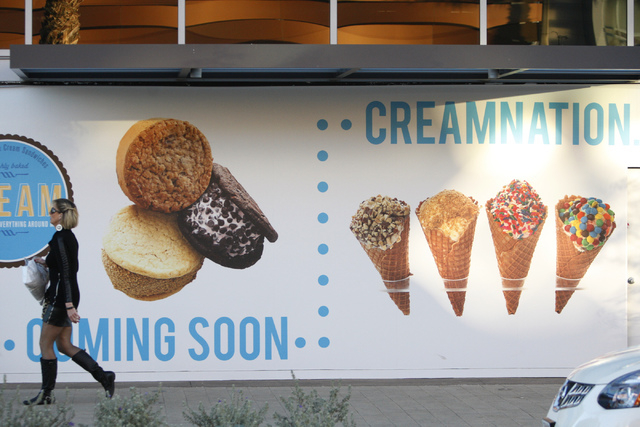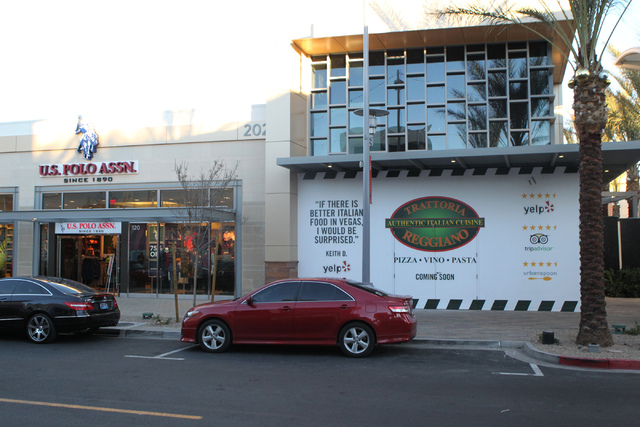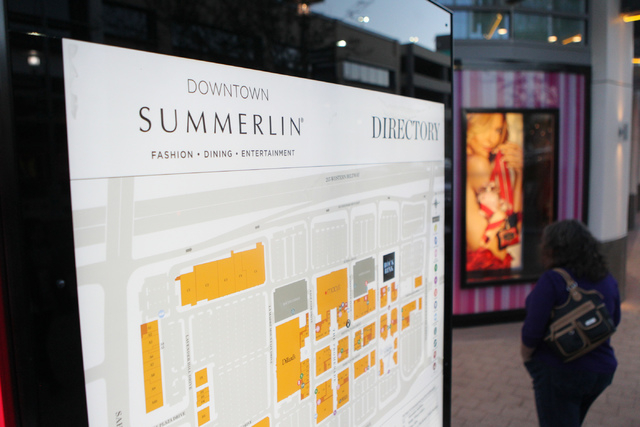Howard Hughes Corp. plans on building on momentum in ‘15
Sure, 2014 was an important year for Summerlin, as the master-planned community revived the urban core it put on hold in the recession.
But 2015 promises to be even bigger for the massive master plan along the Las Vegas Valley’s western edge. Officials with the community’s developer, The Howard Hughes Corp., said they’re poised to build on the momentum of the October opening of Downtown Summerlin.
On tap in coming months are Summerlin’s first new residential village since the recession, its first age-restricted community since the 1990s, a market-testing luxury-apartment neighborhood and a resort-style housing development that could well end up being the state’s priciest residential project.
All of that anticipated activity has implications for Southern Nevada’s economy. Because Summerlin makes up 10 percent to 12 percent of the region’s housing market, what it does could shape development valleywide, experts said.
“Summerlin is a leader in the residential area. It sets the trends and it sets the sentiments,” said local economist John Restrepo, who’s conducted a number of housing-absorption studies of master plans including Summerlin, Green Valley Ranch and Southern Highlands for local municipalities. “Other builders look at Summerlin and say, ‘OK, let’s see what they’re doing.’”
Dennis Smith, president and CEO of housing analysis firm Home Builders Research, called the plans a vote of confidence in the local economy. As Summerlin builds out, “you’re going to see money start loosening up, and more developments start to show up” around the valley, he said.
“I think that if Summerlin does well, the rest of the market will follow,” he said.
Summerlin officials acknowledge the local market is still recovering from its recession, which ranked among the nation’s worst downturns if you weigh measures including unemployment and dips in home prices. But they said the economy is headed in the right direction, given big project openings such as Downtown Summerlin and SLS Las Vegas on the Strip. The on-the-mend trend warrants “ramping up,” said Kevin Orrock, president of Summerlin and vice president of master-planned communities for The Howard Hughes Corp.
“We’re bullish on the market. When we look at the Southern Nevada economy, it feels good. People are excited. It isn’t what it was at the peak, but it doesn’t need to be. What we need is a good, sustainable market, which I think we’re seeing now. We’re way off of what I would call a normal market, but we’re also off of the bottom, so we’re all moving in a good direction.”
For Summerlin, that direction will include nearly 40 new-home models and 60 floor plans in as many as 20 new-home subdivisions — about 70 percent of its pre-recession sales and marketing activity. In all, Las Vegas is forecast to close on about 5,000 new homes in 2015, and Orrock said Summerlin will be behind 10 percent to 12 percent of that volume. That will be well below the 3,000 homes a year the master plan sold in the boom, but an improvement over its 200 annual sales in the recession. New-home prices in the community start in the high $200,000s.
More than 90 percent of Summerlin’s new units in 2015 will be single-family production homes.
FIRST NEW VILLAGE SINCE RECESSION
For starters, Summerlin is preparing for the launch of its first new village since the recession. The Cliffs, at the master plan’s southernmost tip near Hualapai Way and Patrick Lane, will have a design aesthetic new to Summerlin’s traditional stucco-and-tile-roof production homes. Its “desert contemporary” look will require builders to design flat roofs, and to use finishes including metal, glass and various types of woods.
Within The Cliffs, The Howard Hughes Corp. will also unveil its first local age-qualified community since Sun City Summerlin, completed in 1999. Regency, a 55-and-up community that luxury builder Toll Brothers will develop, will be considerably smaller and “more intimate” than the 2,500-acre, 8,000-home Sun City, Orrock said. Regency will have just 425 homes on 100 acres. Nor will it have a golf course: Its primary amenity will be a trail system that connects to Summerlin’s larger network of pedestrian and bike pathways.
“In the 15 years since we started our first age-qualified community, ideas have evolved a great degree,” Orrock said. “You’re going to see baby boomers who are really very active, and that’s why trail systems will be such a big part of the development.”
Summerlin’s Paseos village will also roll out six new neighborhoods that will ultimately have up to 800 homes.
But The Howard Hughes Corp. isn’t betting solely on single-family production homes in 2015.
It will partner with Discovery Land Co. of Arizona to begin building 250 homes on 555 acres. With lots as big as three acres, the project will be the lowest-density neighborhood planned in the market. It’ll also be the priciest, with lot prices ranging from $2 million to $8 million, and finished homes from $1.5 million to more than $12 million. The community, at Tropicana Avenue and Town Center Drive, will also have an 18-hole, Tom Fazio-designed golf course and a private fitness center and spa with a five-star chef and consulting doctors who will design nutritional and wellness plans for residents.
The Howard Hughes Corp. also has a joint-venture agreement with The Calida Group to build a 124-unit luxury apartment complex on 4.5 acres at Griffith Peak and Town Center drives in east Downtown Summerlin. The Constellation, which will have a spa and a masseuse and aesthetician on call for residents, will seek rents “at the top of the market,” executives with The Calida Group told the Review-Journal in November. Construction is scheduled to start the first week of January, and residents are scheduled to begin moving in by the end of 2015.
But is it all too much for a still-recovering market?
Observers said no.
‘SUSTAINED RECOVERY’
Restrepo noted that there’s still relatively little new residential development happening valleywide. The market’s 5,000 to 6,000 closings a year remain well below the 30,000-plus annual sales of the boom.
What’s more, the local economy is in “sustained recovery mode now,” with strong job gains, stabilizing home prices and the first signs of real wage growth, he said.
Smith said he also believes the new developments will likely succeed.
The apartment market has been trending toward the high end in recent years, he said. Gains in the stock market and in home equity among affluent Californians and foreign investors should help the high-end housing segment. And the market has pent-up demand for age-restricted housing, given that Henderson’s Anthem master plan — the last age-qualified community to come online locally — wrapped up most of its sales more than half a decade ago. Henderson’s Cadence community also plans to build an age-restricted subdivision.
Orrock added that Summerlin’s fortunes in 2015 should get a boost from a lack of developable acreage elsewhere in the valley.
Smith agreed.
“Summerlin is huge for the market because that’s where the land is, and where the builders are. I think that whole area around Red Rock Canyon is going to be a real hub of Las Vegas housing development for a while. Summerlin is very important to what we do in terms of overall market numbers,” he said.
Summerlin, which has been in development since 1990, has 5,400 developable acres left of its 22,500-acre total. Of the 31 villages planned, 19 are completed or under construction. There’s room for 40,000 more homes, and another 100,000 residents on top of the 100,000 who already call the master plan home, Orrock said.
Summerlin’s build-out is scheduled for sometime between 2020 and 2025.
Contact Jennifer Robison at jrobison@reviewjournal.com. Find her on Twitter: @J_Robison1.


























